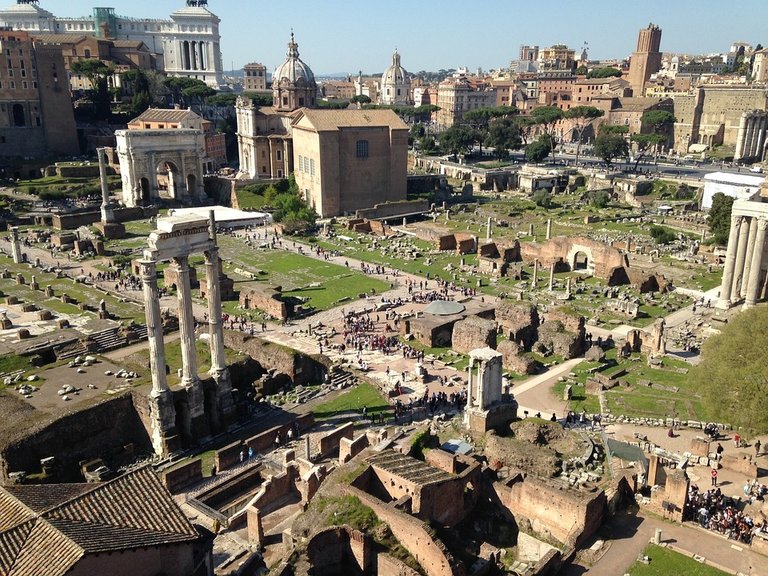Christmas is one of the most important festivities in the year, worldwide. Christianism celebrates the birth of Jesus. If we look a bit back in time we find several christian artworks that are very influenced by older pagan Roman works. In the same way, we can relate the festivities and similarities that the christian savior has with certain pagan gods.

In ancient Rome, really "hot" celebrations were performed: The Saturnalia festivals. Along with the Roman triumph (Triumphus) that was linked to the arrival of victorious generals back to Rome. During the Saturnalia the society played along a swap of social roles game: The lords behaved as slaves and the slaves as lords; what was forbidden became allowed, and what was restricted became free and wasted.
Ancient Rome's holidays had their origin in religion. The public celebration consisted in one or two days dedicated to the gods. The axis resided in certain sacrifices or rituals, like dances. Such acts were performed in the name of the political community, that was at the same time a religious community. Worship and sacrifice was a method to "stay in peace" with the gods, a situation that was always threatened. From the sowing until the harvest, those magic forces had to be calmed down somehow.
Resuming, there were holidays that were performed as a requirement of certain events like natural catastrophes or military victories or defeats. While others were held traditionally as a follow up of the agricultural stages this festival was dedicated to the god Saturn.
The Saturnalia
This festival was celebrated from december 17th to the 23th honoring the god of agriculture, Saturn; lit up by candles and torches celebrating the end of the darkest period of the year and birth of a new light period. They probably also were the party celebrating the end of the agricultural works, after the winter sow, when the pace of seasons left little work to be done by landlords and slaves alike; then they had time to relax from that daily labor

Saturnalia by Ernesto Biondi (1909), in the Buenos Aires Botanical Gardens by - Roberto Fiadone
when the field labors were over and the longest night arrived, Romans relaxed, hung their clothes, dressed up for a party and for a couple of days forgot about the rules that oppressed them the rest of the year. Everything started at the Saturn temple with a nice feast (lectisternium) and a crow screaming: "Io, Saturnalia!!!".
Seven days of party, feasts and gift exchanges. It all started with the sacrifices at the temple (Imagine the magnitude, he WAS the most important god for the Romans; more important than Jupiter himself!), followed by public feasts where EVERYONE was invited. Romans related Saturn to the Phehellenic god Chronos that was active during Earth's golden age. During the Saturnalia, slaves were free from their responsibilities and swapped roles with their masters (you can see a couple of video examples at youp*rn).
Officially this was a holiday that was celebrated the 17th, but the populace appreciated Saturn (and partying) so much that they lengthened it until the 23th. The state was forced to cope with it and allow it, since they blatantly failed to attempr to reduce it to 3 or 5 days. By the end of the 1st century it was set in 5 days.

Romans exchanged gift (just like us during Christmas), visited friends and relatives (just like us in Christmas) and later had a bed marathon (just like us during Christmas).
Not only slaves swapped roles with their masters, children swapped roles with their parents. Each family also picked a "king of Saturnalia", and that could be a child, he presided the parties and had to be obeyed no matter how bizarre his orders were. During those holidays, schools, shops and legal offices were closed (just like us during Christmas). Even wars were stopped! (that, we didn't copy).
When the Saturnalia finished, in December 25th the "Sol Natalis Solis Invictis" (birth of the Unconquered Sun) was celebrated, personified in the god Mithra of Persian origin; this became a dominant religion in Rome, especially among soldiers.
After the 25th, the Sigillaria festival started (oh boy! this guys knew how to party!), dedicated, mostly, to give gifts to children: rings, dolls, writing pads, dice, small toys, coins and bags full of marbles!!!

There are children playing with balls, marbles, and dancing. This expresses the ancient Roman children were just like any other child. - Source
During those days houses were decorated with green leaves, candles were lit (justl ike us with Christmas lights) and figures were hung from trees (Do I need to say it again?). Now, they were not fool enough to get the trees inside their houses, that is a tradition that was born during the 16th century
Sol Invictus
One of the most popular gods in Rome was "Deus Sol Invictus", and Romans worshiped him weekly during the "dies solis" (literal translation: Sun-Day). Constantine the Great, that was also a Sol Invictus high priest, ordered that this day should also be a holiday for the Christians.
Sol Invictus' religion is inspired from the Mithraic religion, very famous among Roman soldiers of the 1st century B.C. It celebrated a very similar thing that was celebrated during the Saturnalia festivals, the end of the darkest period of the year and birth of a new light period. Matching the winter solstice, Sol Invictus was a sign of rebirth.
God Mithra
Also, there's some similarities among religions back then. Mitha was born the same day than the Christian nativity day (birthday, christmas), in a primitive cave, near a fountain where a couple of wise men come close to worship him.
Mithraism had a huge influence in Christianism. The similarities would represent a feast for Steemcleaners if those were two posts, yet, Christianism overwhelmed Mithraism around the 4th century, remaining as unique religion of the Roman Empire.
The religious world is a complex one, where cross references make you hop from one to another in no time. Making you sometimes doubt which one came first. But, religions play such a role in humankind actions that it is vital to understand their history to understand our species.
Thankfully (?) Christmas did lose the religious tint it had so many centuries to now be called Xmas by a huge majority. Now it is honoring a modern god, money, where consumerism is encouraged. (If you ask me I prefer a shopping spree instead of a religious war, crusade, jihad).
These holidays became part of our worldwide cultural imprint, a moment, an excuse to exchange gifts, good moments and joy. So, no matter on which unicorn or legendary imaginary friend you believe: Merry holidays!
If you liked this post and its informal way of talking about sciences, please, follow me for more!
Leave a comment either for good or for bad reviews. I take everything as constructive, and I really appreciate the feedback, even from trolls (at least a troll read it before being himself!).
Copyrights:
All the previously used images are of my authory or under a CC0 license (Source: pixabay), unless openly stated.
All the Images created by me possess a WTFPL licencing and they are free to redistribute, share, copy, paste, modify, sell, crop, paste, clone in whatever way you want.
This post has been ranked within the top 50 most undervalued posts in the first half of Dec 24. We estimate that this post is undervalued by $5.75 as compared to a scenario in which every voter had an equal say.
See the full rankings and details in The Daily Tribune: Dec 24 - Part I. You can also read about some of our methodology, data analysis and technical details in our initial post.
If you are the author and would prefer not to receive these comments, simply reply "Stop" to this comment.
Hail
SatanSanta!Io Saturnalia to you as well! :-D
Nice info. May be worth mentioning that Jesus' birthday is not even the 25th. Christmas being on the 25th came as result of Emperor Constantine the Great merging Paganism and Christianity to appease his divided populous. This is also when the Sabbath day was changed to Sunday, a blatant Pagan reference to Sun worship.
Thank you for sharing this. I don't think many people know the roots of the celebration they take part in every year.
I was about to add that there's no way a dove can fertilize a woman... But I try to stay away from being too blunt to the always friendly and tolerant christian community. They don't like you talking about their comic books.
I think you will find that Steemit community--at least at the moment--is a lot more open-minded and open to discussion than you'd think.
I made a post a couple of days ago expressing in depth the problems I have that prevent me from believing in the Bible and it was received very well -- in spite of many cases of what some would call blasphemy.
Next time you ought to just say what's on your mind.
I'm a believer of evidence, there's never an absolute truth, yet sciences get us closer at every step.
This is an excellent an answer. Retain that perspective if you can.
Meh, I prefer to stay away from cheap soap-operas. I believe in science books, others believe on jewish fairy tales about a superman... Each one is happy that way.
Science books yeah..? Are you a believer in evolution then?
IO Saturnalia! Pagan & proud